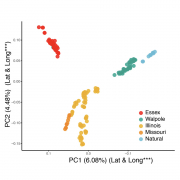Last preprint of 2018: Evolution of herbicide resistance
Multiple modes of convergent adaptation in the spread of glyphosate-resistant Amaranthus tuberculatus
Julia M. Kreiner, Darci Giacomini, Felix Bemm, Bridgit Waithaka, Julian Regalado, Christa Lanz, Julia Hildebrandt, Peter H. Sikkema, Patrick J. Tranel, Detlef Weigel, John R. Stinchcombe, Stephen I. Wright
bioRxiv 498519, posted December 17, 2018
The selection pressure exerted by herbicides has led to the repeated evolution of resistance in weeds. The evolution of herbicide resistance on contemporary timescales provides an outstanding opportunity to investigate key open questions about the genetics of adaptation, in particular the relative importance of adaptation from new mutations, standing genetic variation, and geographic spread of adaptive alleles through gene flow. Glyphosate-resistant Amaranthus tuberculatus poses one of the most significant threats to crop yields in the midwestern United States, with both agricultural populations and resistance only recently emerging in Canada. To understand the evolutionary mechanisms driving the spread of resistance, we sequenced and assembled the A. tuberculatus genome and investigated the origins and population genomics of 163 resequenced glyphosate-resistant and susceptible individuals in Canada and the USA. In Canada, we discovered multiple modes of convergent evolution: in one locality, resistance appears to have evolved through introductions of preadapted US genotypes, while in another, there is evidence for the independent evolution of resistance on genomic backgrounds that are historically non-agricultural. Moreover, resistance on these local, non-agricultural backgrounds appears to have occurred predominantly through the partial sweep of a single amplification haplotype. In contrast, US genotypes and those in Canada introduced from the US show multiple amplification haplotypes segregating both between and within populations. Therefore, while the remarkable diversity of A. tuberculatus has facilitated geographic parallel adaptation of glyphosate resistance, different timescales of selection have favored either adaptation from standing variation or de novo mutation in certain parts of the range.




